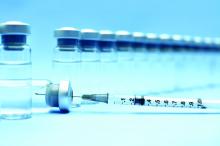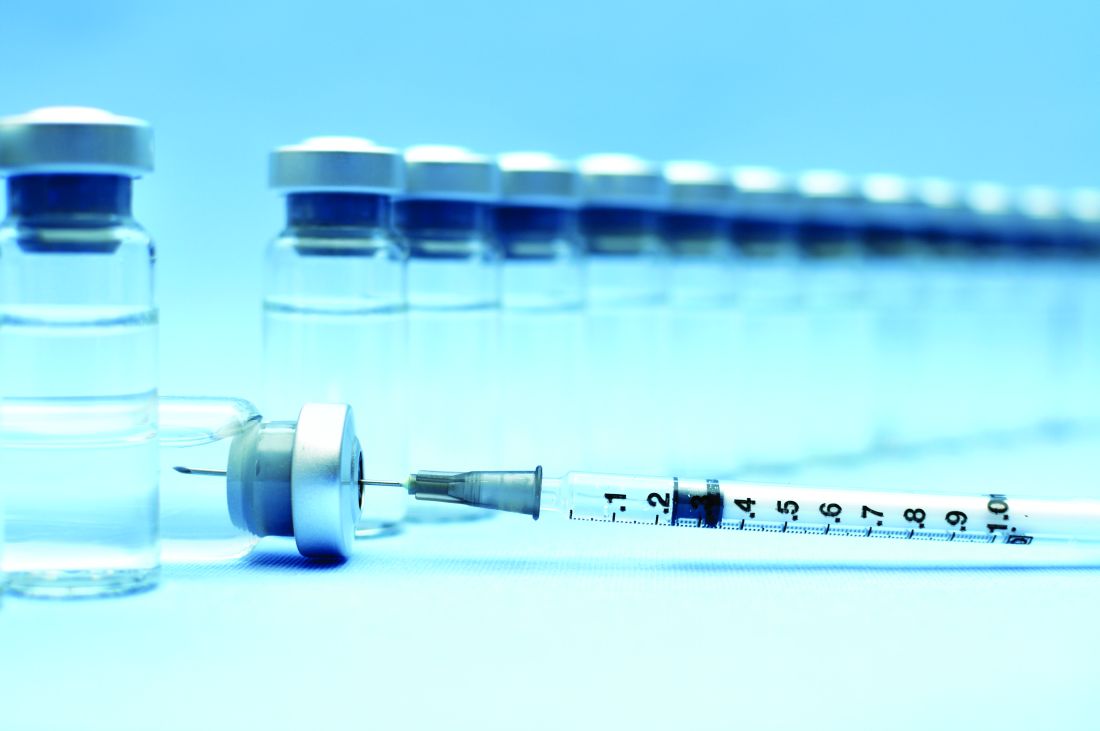User login
Maternal antibody concentrations continue to affect children’s immune response to their first and later vaccine doses as late as age 2 years, according to study findings.
Greater spacing between doses did not eliminate the maternal antibody effects, the research published in JAMA Pediatrics showed.
“Our analysis comprehensively models the effects of maternal antibody inhibition and infant age at vaccination on the majority of vaccine antigens contained in current global infant immunization programs and reveals that, for almost all antigens, transplacental antibody inhibits the antibody response to priming vaccinations,” wrote Merryn Voysey of the University of Oxford (England), and her associates.
Booster doses do not diminish the effect, the authors add. “These analyses further reveal the benefit of infants being older when first immunized, an association that remains after adjusting for waning maternal antibody levels” (JAMA Pediatrics. 2017 May 15. doi: 10.1001/jamapediatrics.2017.0638).
Although the blunting from maternal antibodies has been long understood for the measles vaccine, this new study showed that even conjugate vaccines have this blunting in infancy, both due to “preexisting antibodies to the polysaccharide antigen [and] from antibodies associated with carrier proteins,” the authors wrote, referring to findings related to pneumococcal conjugate vaccines.
“Therefore, prenatal immunization programs containing multicomponent vaccines have the potential to interfere with the immunogenicity of current immunization programs,” Ms. Voysey and her colleagues wrote.
The authors requested and then analyzed deidentified participant data from GlaxoSmithKline vaccine immunogenicity clinical trials in which antibody concentration data were available before and after infants’ first vaccine dose. The analysis included 7,630 infants enrolled in 32 studies in 17 countries from Europe, Africa, Latin America, East Asia, Russia, and Australia. About half were boys, and infants’ mean age at baseline was 9 weeks.
The researchers found that infants’ antibody responses were blunted for 20 of 21 antigens due to maternal antibodies they still had. The inactivated polio vaccine was affected the most: a maternal antibody twice as high as other infants’ resulted in a 20% lower antibody geometric mean ratio for type 1 and a 28% lower antibody geometric mean ratio for type 2 after vaccination.
All three vaccines in the DTaP showed inhibited responses as well. Having twice as high a maternal antibody for acellular pertussis antigens resulted in an 11% reduction in infants’ antibody for both pertussis toxoid and filamentous hemagglutinin. Antibody for pertactin was 22% lower. Double the maternal antibody for tetanus translated to 13% lower response, and diphtheria antibody was similarly 24% lower.
Even at 12-24 months, children showed a blunted response due to maternal antibodies for the acellular pertussis, inactivated polio, and diphtheria vaccines. For each additional month of age children were when first immunized, their antibody response ranged from 10%-71% greater for 18 of 21 antigens, after accounting for the influence of maternal antibodies.
“In contrast to previous reports, the effects of maternal antibodies and the infant’s age when first immunized are not only seen in response to a priming series of vaccines, but continue to affect antibody responses to booster vaccinations at ages 12 to 24 months for many antigens,” the authors reported. “This finding suggests the importance of the quality of the immune response to the first dose of antigen, regardless of subsequent doses.”
For example, delaying administration of a first vaccine dose by 2-5 weeks resulted in offsetting a two- to fivefold greater concentration of maternal pertussis antibodies. To offset similarly higher maternal antibody concentrations for the other components of the DTaP would require a delay of 3-6 weeks for diphtheria and 2-4 weeks for tetanus.
The research funding came from the National Institute for Health Research via a fellowship of one author and salary support of another. Ms. Voysey had no relevant financial disclosures. Most of her colleagues received research grants or other assistance from pharmaceutical companies.
Maternal antibody concentrations continue to affect children’s immune response to their first and later vaccine doses as late as age 2 years, according to study findings.
Greater spacing between doses did not eliminate the maternal antibody effects, the research published in JAMA Pediatrics showed.
“Our analysis comprehensively models the effects of maternal antibody inhibition and infant age at vaccination on the majority of vaccine antigens contained in current global infant immunization programs and reveals that, for almost all antigens, transplacental antibody inhibits the antibody response to priming vaccinations,” wrote Merryn Voysey of the University of Oxford (England), and her associates.
Booster doses do not diminish the effect, the authors add. “These analyses further reveal the benefit of infants being older when first immunized, an association that remains after adjusting for waning maternal antibody levels” (JAMA Pediatrics. 2017 May 15. doi: 10.1001/jamapediatrics.2017.0638).
Although the blunting from maternal antibodies has been long understood for the measles vaccine, this new study showed that even conjugate vaccines have this blunting in infancy, both due to “preexisting antibodies to the polysaccharide antigen [and] from antibodies associated with carrier proteins,” the authors wrote, referring to findings related to pneumococcal conjugate vaccines.
“Therefore, prenatal immunization programs containing multicomponent vaccines have the potential to interfere with the immunogenicity of current immunization programs,” Ms. Voysey and her colleagues wrote.
The authors requested and then analyzed deidentified participant data from GlaxoSmithKline vaccine immunogenicity clinical trials in which antibody concentration data were available before and after infants’ first vaccine dose. The analysis included 7,630 infants enrolled in 32 studies in 17 countries from Europe, Africa, Latin America, East Asia, Russia, and Australia. About half were boys, and infants’ mean age at baseline was 9 weeks.
The researchers found that infants’ antibody responses were blunted for 20 of 21 antigens due to maternal antibodies they still had. The inactivated polio vaccine was affected the most: a maternal antibody twice as high as other infants’ resulted in a 20% lower antibody geometric mean ratio for type 1 and a 28% lower antibody geometric mean ratio for type 2 after vaccination.
All three vaccines in the DTaP showed inhibited responses as well. Having twice as high a maternal antibody for acellular pertussis antigens resulted in an 11% reduction in infants’ antibody for both pertussis toxoid and filamentous hemagglutinin. Antibody for pertactin was 22% lower. Double the maternal antibody for tetanus translated to 13% lower response, and diphtheria antibody was similarly 24% lower.
Even at 12-24 months, children showed a blunted response due to maternal antibodies for the acellular pertussis, inactivated polio, and diphtheria vaccines. For each additional month of age children were when first immunized, their antibody response ranged from 10%-71% greater for 18 of 21 antigens, after accounting for the influence of maternal antibodies.
“In contrast to previous reports, the effects of maternal antibodies and the infant’s age when first immunized are not only seen in response to a priming series of vaccines, but continue to affect antibody responses to booster vaccinations at ages 12 to 24 months for many antigens,” the authors reported. “This finding suggests the importance of the quality of the immune response to the first dose of antigen, regardless of subsequent doses.”
For example, delaying administration of a first vaccine dose by 2-5 weeks resulted in offsetting a two- to fivefold greater concentration of maternal pertussis antibodies. To offset similarly higher maternal antibody concentrations for the other components of the DTaP would require a delay of 3-6 weeks for diphtheria and 2-4 weeks for tetanus.
The research funding came from the National Institute for Health Research via a fellowship of one author and salary support of another. Ms. Voysey had no relevant financial disclosures. Most of her colleagues received research grants or other assistance from pharmaceutical companies.
Maternal antibody concentrations continue to affect children’s immune response to their first and later vaccine doses as late as age 2 years, according to study findings.
Greater spacing between doses did not eliminate the maternal antibody effects, the research published in JAMA Pediatrics showed.
“Our analysis comprehensively models the effects of maternal antibody inhibition and infant age at vaccination on the majority of vaccine antigens contained in current global infant immunization programs and reveals that, for almost all antigens, transplacental antibody inhibits the antibody response to priming vaccinations,” wrote Merryn Voysey of the University of Oxford (England), and her associates.
Booster doses do not diminish the effect, the authors add. “These analyses further reveal the benefit of infants being older when first immunized, an association that remains after adjusting for waning maternal antibody levels” (JAMA Pediatrics. 2017 May 15. doi: 10.1001/jamapediatrics.2017.0638).
Although the blunting from maternal antibodies has been long understood for the measles vaccine, this new study showed that even conjugate vaccines have this blunting in infancy, both due to “preexisting antibodies to the polysaccharide antigen [and] from antibodies associated with carrier proteins,” the authors wrote, referring to findings related to pneumococcal conjugate vaccines.
“Therefore, prenatal immunization programs containing multicomponent vaccines have the potential to interfere with the immunogenicity of current immunization programs,” Ms. Voysey and her colleagues wrote.
The authors requested and then analyzed deidentified participant data from GlaxoSmithKline vaccine immunogenicity clinical trials in which antibody concentration data were available before and after infants’ first vaccine dose. The analysis included 7,630 infants enrolled in 32 studies in 17 countries from Europe, Africa, Latin America, East Asia, Russia, and Australia. About half were boys, and infants’ mean age at baseline was 9 weeks.
The researchers found that infants’ antibody responses were blunted for 20 of 21 antigens due to maternal antibodies they still had. The inactivated polio vaccine was affected the most: a maternal antibody twice as high as other infants’ resulted in a 20% lower antibody geometric mean ratio for type 1 and a 28% lower antibody geometric mean ratio for type 2 after vaccination.
All three vaccines in the DTaP showed inhibited responses as well. Having twice as high a maternal antibody for acellular pertussis antigens resulted in an 11% reduction in infants’ antibody for both pertussis toxoid and filamentous hemagglutinin. Antibody for pertactin was 22% lower. Double the maternal antibody for tetanus translated to 13% lower response, and diphtheria antibody was similarly 24% lower.
Even at 12-24 months, children showed a blunted response due to maternal antibodies for the acellular pertussis, inactivated polio, and diphtheria vaccines. For each additional month of age children were when first immunized, their antibody response ranged from 10%-71% greater for 18 of 21 antigens, after accounting for the influence of maternal antibodies.
“In contrast to previous reports, the effects of maternal antibodies and the infant’s age when first immunized are not only seen in response to a priming series of vaccines, but continue to affect antibody responses to booster vaccinations at ages 12 to 24 months for many antigens,” the authors reported. “This finding suggests the importance of the quality of the immune response to the first dose of antigen, regardless of subsequent doses.”
For example, delaying administration of a first vaccine dose by 2-5 weeks resulted in offsetting a two- to fivefold greater concentration of maternal pertussis antibodies. To offset similarly higher maternal antibody concentrations for the other components of the DTaP would require a delay of 3-6 weeks for diphtheria and 2-4 weeks for tetanus.
The research funding came from the National Institute for Health Research via a fellowship of one author and salary support of another. Ms. Voysey had no relevant financial disclosures. Most of her colleagues received research grants or other assistance from pharmaceutical companies.
FROM JAMA PEDIATRICS
Key clinical point:
Major finding: Infants’ antibody concentrations after vaccination were inhibited for 20 of 21 antigens after a first dose and for 18 of 21 antigens up to 24 months later.
Data source: The findings are based on an analysis of pre- and postimmunization antibody concentrations to 21 vaccine antigens in 7,630 infants enrolled in 32 immunogenicity clinical studies in 17 countries.
Disclosures: The research funding came from the National Institute for Health Research via a fellowship of one author and salary support of another. Ms. Voysey had no relevant financial disclosures. Most of her colleagues received research grants or other assistance from pharmaceutical companies.

